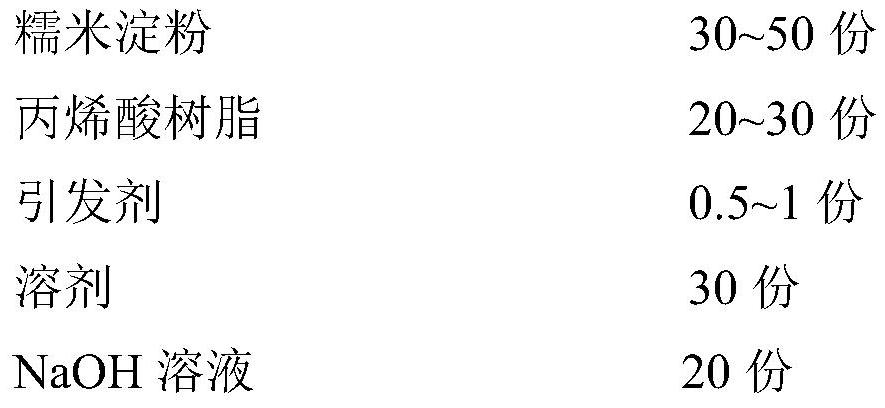Hydrophilic membrane and preparation method thereof
A hydrophilic film and hydrophilic technology, applied in the direction of coating, etc., can solve the problems of toxic shock syndrome, skin allergic reaction, unsatisfactory water retention rate, etc., and achieve the effect of high water absorption performance
- Summary
- Abstract
- Description
- Claims
- Application Information
AI Technical Summary
Problems solved by technology
Method used
Image
Examples
Embodiment 1
[0035] (1) Preparation method of modified starch resin: Add 30 parts of glutinous rice starch into a three-necked flask with a stirrer, then add distilled water and stir at 60°C for gelatinization; cool to room temperature, and then add 20 parts of acrylic acid to the gelatinized starch Resin, 30 parts of isopropanol, 0.5 parts of 2,4-dihydroxybenzophenone and 20 parts of 7% NaOH solution are mixed evenly and placed under a 1200W ultraviolet lamp for polymerization. The temperature is controlled at 20-30°C and filtered Then dry in an oven at 85°C for 12 hours, and pulverize the obtained material to obtain the desired modified starch resin;
[0036] (2) Preparation method of hydrophilic fiber film: Mix 40 parts of modified starch resin, 20 parts of polyglycolic acid, and 1 part of cyanoguanidine evenly, and then melt, extrude, blown film and solidify at 240°C to obtain the desired hydrophilic Fiber membrane;
[0037] (3) Preparation method of hydrophilic coating: add 20 parts ...
Embodiment 2
[0040] (1) Preparation method of modified starch resin: Add 50 parts of glutinous rice starch into a three-necked flask with a stirrer, then add distilled water and stir at 60°C for gelatinization; cool to room temperature, then add 30 parts of acrylic acid to the gelatinized starch Resin, 30 parts of isopropanol, 1 part of 2,4-dihydroxybenzophenone and 20 parts of 7% NaOH solution are mixed evenly and placed under a 1200W ultraviolet lamp for polymerization, the temperature is controlled at 20-30 ° C, filtered Then dry in an oven at 85°C for 12 hours, and pulverize the obtained material to obtain the desired modified starch resin;
[0041] (2) Preparation method of hydrophilic fiber film: Mix 50 parts of modified starch resin, 30 parts of polyglycolic acid, and 4 parts of cyanoguanidine, and then melt, extrude, blown film and solidify at 240°C to obtain the desired hydrophilic Fiber membrane;
[0042] (3) Preparation method of hydrophilic coating: add 30 parts of PVA to 30 p...
Embodiment 3
[0045] (1) Preparation method of modified starch resin: Add 40 parts of glutinous rice starch into a three-necked flask with a stirrer, then add distilled water and stir at 60°C for gelatinization; cool to room temperature, and then add 25 parts of acrylic acid to the gelatinized starch Resin, 30 parts of isopropanol, 0.8 parts of 2,4-dihydroxybenzophenone and 20 parts of 7% NaOH solution are mixed evenly and placed under a 1200W ultraviolet lamp for polymerization, the temperature is controlled at 20-30 °C, and filtered Then dry in an oven at 85°C for 12 hours, and pulverize the obtained material to obtain the desired modified starch resin;
[0046] (2) Preparation method of hydrophilic fiber film: Mix 60 parts of modified starch resin, 25 parts of polyglycolic acid, and 2 parts of cyanoguanidine evenly, and then melt, extrude, blown film and solidify at 240°C to obtain the desired hydrophilic Fiber membrane;
[0047] (3) Preparation method of hydrophilic coating: Add 25 par...
PUM
| Property | Measurement | Unit |
|---|---|---|
| thickness | aaaaa | aaaaa |
| diameter | aaaaa | aaaaa |
| alcoholysis degree | aaaaa | aaaaa |
Abstract
Description
Claims
Application Information
 Login to View More
Login to View More - R&D
- Intellectual Property
- Life Sciences
- Materials
- Tech Scout
- Unparalleled Data Quality
- Higher Quality Content
- 60% Fewer Hallucinations
Browse by: Latest US Patents, China's latest patents, Technical Efficacy Thesaurus, Application Domain, Technology Topic, Popular Technical Reports.
© 2025 PatSnap. All rights reserved.Legal|Privacy policy|Modern Slavery Act Transparency Statement|Sitemap|About US| Contact US: help@patsnap.com



